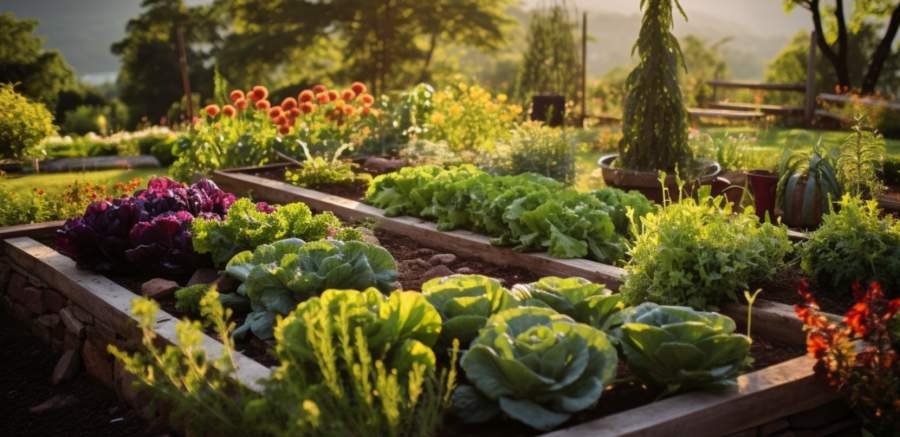Companion Planting for a Healthy Garden

Of Cabbages and Kings: A Royal Introduction
Imagine, if you will, a land where cabbages are kings, and tomatoes are queens. Picture rows upon rows of sprightly lettuce, keeping the peace between factions of feisty peppers and regal eggplants. This, my friends, is the world of companion planting, where vegetables coexist in perfect harmony, while silently plotting to dominate the world - or, at least, your garden.Companion planting is the horticultural equivalent of a successful marriage: two plants that complement each other's strengths and weaknesses to create a healthier, more bountiful garden. It's a centuries-old technique that can help control pests, improve soil fertility, and boost crop yields. You may be skeptical, but fear not! I'm here to guide you through the twists and turns of companion planting so you can transform your garden into a utopian paradise of edible delights.
The Three Sisters: A Timeless Tale of Plant Synergy
Long before the first hipster donned a pair of overalls and took up urban gardening, Native Americans cultivated the "Three Sisters": corn, beans, and squash. This trio of crops forms a symbiotic relationship that benefits all three plants. The cornstalks act as natural trellises for the beans to climb, while the beans fix nitrogen in the soil to nourish the corn. The squash's large leaves shade the soil, keeping it cool and moist while discouraging weeds and pests. It's a prime example of companion planting at its finest.Some Assembly Required: Pairing Plants Like a Pro
Now that you've grasped the concept of companion planting, it's time to dig into the nitty-gritty details. Here are some tried-and-true plant pairings guaranteed to bring joy to your garden and your taste buds:- Tomatoes and Basil: These two culinary staples are a match made in heaven. Basil is believed to repel tomato hornworms and enhance the flavor of tomatoes, while the tomato plant provides shade for the delicate basil leaves.
- Carrots and Onions: The strong scent of onions deters carrot-loving pests like carrot fly, while carrots" feathery foliage provides a hiding place for beneficial insects like ladybugs.
- Peppers and Marigolds: Plant marigolds among your peppers to keep aphids and other pests at bay. The marigold's pungent aroma confuses insects, protecting your peppers from harm.
- Radishes and Spinach: Radishes grow quickly, breaking up the soil and making it easier for the slower-growing spinach to take root.
Do's and Don'ts: Tips for a Companion Planting Success
While companion planting can be a game-changer for your garden, there are some essential tips to keep in mind:- Do consider the specific needs of each plant. While some plants thrive on chaos, others prefer peace and quiet. Make sure each plant has the right amount of sun, shade, and moisture to reach its full potential.
- Don't plant the same types of vegetables in the same spot year after year. This can deplete the soil of nutrients and encourage pests and diseases. Rotate your crops to keep your soil and plants healthy.
- Do let a few of your plants go to seed. This attracts beneficial insects that help keep pests in check.
- Don't shy away from experimentation. Try new plant combinations, and don't be afraid to mix flowers and herbs with your vegetables. You might just stumble upon the next great companion planting breakthrough!
Epilogue: A Garden of Earthly Delights
As you embark on your companion planting journey, take a moment to marvel at the delicate balance of nature, the interplay of light and shadow, the dance of roots and leaves. Your garden is a microcosm of our vast and mysterious universe, and you are its master and commander.So put on your gardening gloves, roll up your sleeves, and dive headfirst into the world of companion planting. Your plants (and your taste buds) will thank you.
Article kindly provided by yourhomengarden.org
Latest Articles
- Why Soil pH Matters More Than You Think for a Healthy Lawn
- Hidden Energy Loss at the Roofline and How to Fix It
- Moisture Mischief and Wooden Floors: What Your Boards Are Trying to Tell You
- Foot Traffic Maps: How to Strategically Protect High Wear Areas on Wood Floors
- Clearing the Clutter Without Losing the Plot
- Why Damp Feels Worse in Some Rooms Than Others
- The Hidden Health Benefits of a Deep Clean
- Uncommon Ways to Estimate Waste Volume Before a Cleanup Project
- How to Spot and Tackle Hidden Moisture Problems Before They Become Renovation Nightmares
- How Underground Pipe Issues Can Lead to Structural Damage
- Simple Design Tricks That Encourage Backyard Biodiversity
- Why Your Showerhead Is Suffering From a Mineral Midlife Crisis
- Gateways That Turn Heads While Keeping Your Property Safe
- Listening Pipes: Using Sound to Diagnose Hidden Home Plumbing Issues
- Small Changes That Make a Kitchen Feel Completely New
- Scents That Refuse to Leave and How to Outwit Them
- How Personalisation Makes Homewares Feel Special
- Asphalt Advantage and the HOA Budget Balancing Act
- The Step-By-Step Process of Turning a Garden Vision into Reality
- Rain Doesn't Fall Straight: Why Roof Shape and Wind Matter More Than You Think
- Interior Design
- Home Improvement
- Gardening
- Home Organization
- Home Maintenance
- DIY Crafts
- Kitchen and Dining
- Bathroom Design
- Home Security
- Home Automation
- Green Living
- Home Office
- Home Decor
- Garden Design
- Pet Care
- Home Technology
- Landscaping
- Home Energy Efficiency
- Home Cleaning
- Home Safety
- Home Exterior
- Home Insulation
- Home Buying
- Home Selling
- Renting
- Tradespeople
- Garage
- Bedroom
- Painting and Decorating
- Plumbing and Drainage

